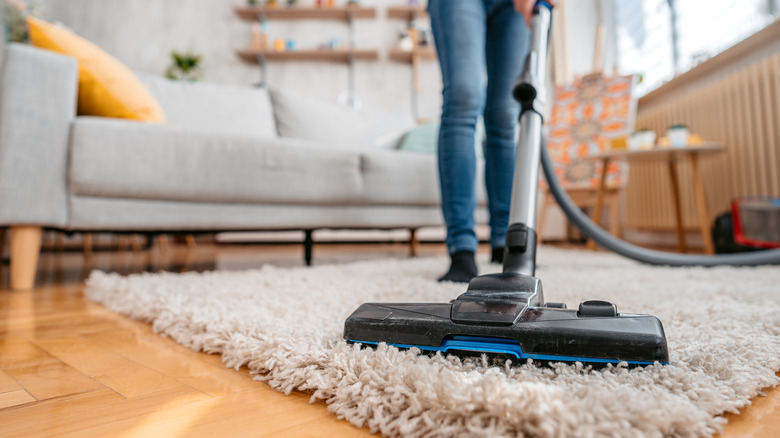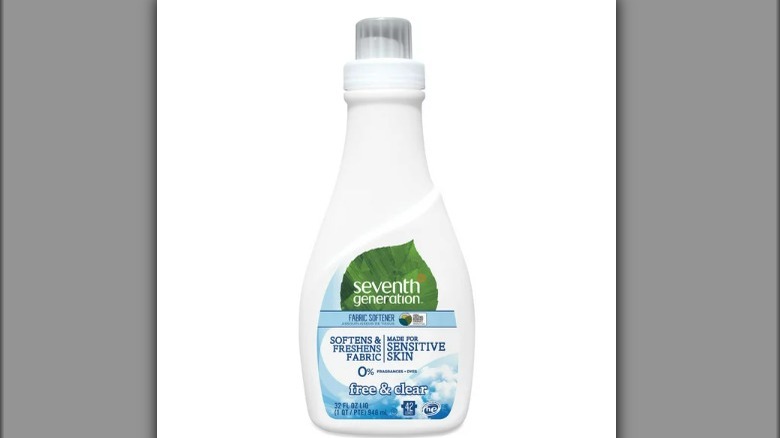Pet Owners Can Use Fabric Softener To Get The Cleanest Carpets Ever
Fabric softeners do more than make your fabrics feel nice to the touch. They work by depositing a thin layer of lubrication on fabric fibers, helping them stay soft. But this property is not confined to your laundry. When applied wisely, fabric softeners can be your secret weapon against pet hair that clings to carpets. As a pet owner, you're likely familiar with the constant presence of animal hair. No matter how often you vacuum, it has a unique ability to weave itself into the very fibers of your carpet. The task of keeping your flooring clean may often seem like a daunting, never-ending cycle of vacuuming, spot-cleaning, and deep cleaning.
When used on carpets, fabric softeners penetrate the carpet fibers, loosening them up just as they do your clothes. Think about the principle at work when you add fabric softener to your laundry. It not only softens your clothes but also helps prevent static cling. This same effect can be used to your advantage when tackling pet hair on your carpets. The softener disrupts the static bond between the pet hair and the fibers, allowing the hair to be removed more easily. That being said, using fabric softener as a weapon against pet hair isn't an overnight miracle; it requires a systematic approach and a little bit of your time. But the payoff? A dramatic reduction in the amount of stubborn pet hair embedded in your carpets. It's a fresh perspective on an age-old problem, offering promising results.
How to use fabric softener as a carpet cleaning agent
Before using fabric softener to clean your carpet, it might help to thoroughly pick up loose dirt and pet hair. Once done, mix one part fabric softener with two parts water in a large spray bottle. Depending on how much pet hair and dirt you're dealing with, you may want to adjust this ratio, but this mixture generally works. Next, lightly spray your carpet with the fabric softener solution. A light mist is sufficient to cover the carpet's surface without drenching the area. Now, allow the solution to sit for a few minutes to penetrate the carpet fibers and break down the dirt and stains before you vacuum. Remember to empty your vacuum cleaner's bag or dust compartment to ensure maximum suction.
In addition to its cleaning properties, fabric softener also acts as a deodorizer, which you can use on your carpet occasionally. You'll need 1 tablespoon of baking soda and 3 tablespoons of fabric softener mixed with warm water. Again, lightly mist the carpet with this solution, avoiding oversaturation. The fabric softener leaves behind a pleasant, lasting scent as the carpet dries, effectively neutralizing pet odors.
Is fabric softener safe for pets?
The attraction of a hair-free carpet is indeed tempting. But as you reach for your favorite fabric softener, have you taken a moment to consider if it's safe for your pets? You see, the most commonly used fabric softeners contain certain chemicals that may hurt them, per Wag. These substances, hidden beneath the alluring scents and promises of softer fabrics, can cause quite a stir in your pet's system. If your pet rolls around on the carpet treated with fabric softener, licks their paws, or even ingests the softener directly, they may experience digestive discomfort, redness, swelling, or even vomiting and wheezing. And, even if they don't ingest it, the softener could cause skin irritation or other external problems.
But don't worry; this doesn't mean you must avoid fabric softeners altogether. There are plenty of non-toxic options that are specifically designed with the safety of your pets in mind. If you carefully observe their labels, you'll notice fewer harmful chemicals, such as artificial dyes and synthetic fragrances. Some popular brands include Seventh Generation Free and Clear, which is free from dyes and is made with plant-based ingredients, per Anasazi Animal Clinic.


